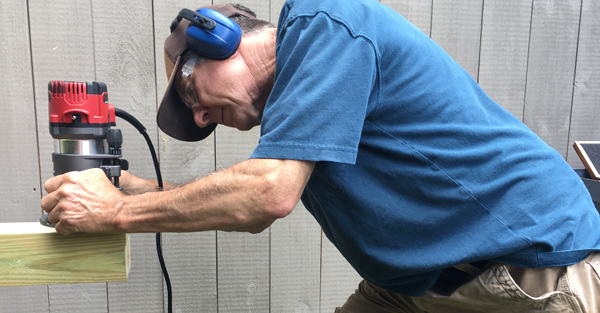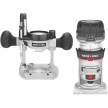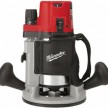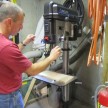SKIL’s Fixed/Plunge-Base Corded Router
SKIL’s Fixed/Plunge-Base Router Hits the Center of the Market 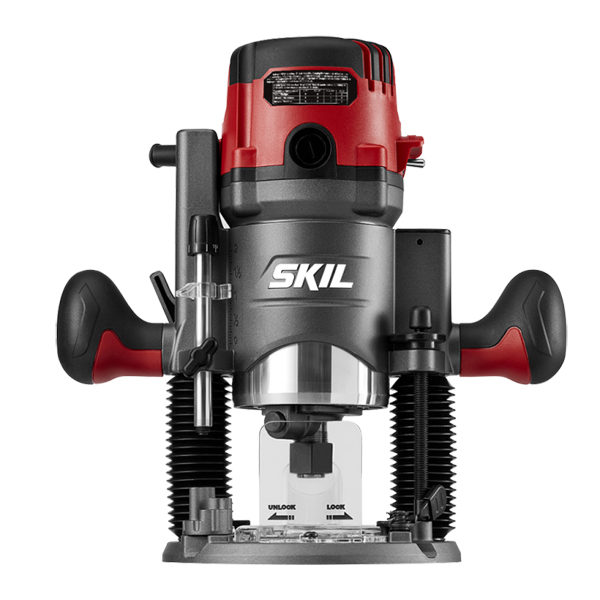
Carpentry can be roughly divided into three main segments, and the SKIL’s Fixed/Plunge-Base Corded Router and sister table and bits can be used in all of them. Not only is it a complete starter set for those new to a router, but it will provide a good use for experienced users in all three carpentry sectors.
Rough carpentry includes things like framing and deck building. At the other end of the scale are woodworking and cabinet making. Bridging the gap is finish carpentry—jobs like trim, molding, and cabinet installation. All three kinds of carpenters use a router. A router and good router table are of course one of the mainstays of woodworkers; finish carpenters often need to break an edge or even create matching molding; framers will use a plunge-base router to remove sheathed-over door and window openings.
A router is a simple tool—essentially it consists of a cutting edge attached in-line to a motor arbor. This simplicity translates to great versatility and also means that it requires a fair amount of skill to use it effectively. For this reason, it’s often one of the tools in the second tier of learning for a new carpenter. But once that carpenter acquires and knows how to use a router, the range of work they can do expands dramatically. They can move beyond cutting and fastening wood to shaping it.
SKIL 14-amp / 2.5 HP Fixed/Plunge-Base Router
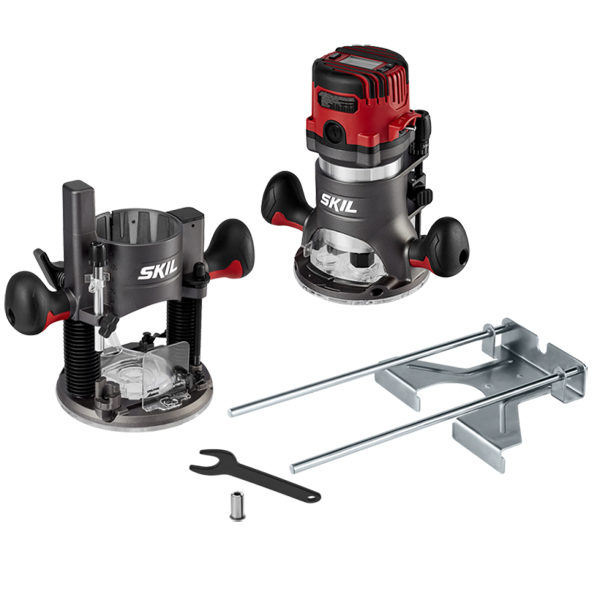
SKIL’s 14-amp / 2.5 HP Fixed/Plunge-Base Router (model RT-1322) is the larger of the two routers in the current SKIL line up. It seems to be more or less an upgraded version of the SKIL 1830 router, which Rob reviewed favorably in 2012. The 1322 squarely hits the needs of 90% of all router jobs except those better suited to a palm router (a small, one-handed lower-powered router for delicate work). The features of the 1322 match what almost all experts consider the needs of most router users most of the time. The 1322 can be thought of as the Ford 150/250 of the router world, equipped with a high-end package.
What’s Included:
- Router
- Parallel Guide
- Collet Wrench
- Fixed Base Dust Extraction Adaptor
- Plunge Base Dust Extraction Adaptor
- 1/4″ & 1/2″ Collet
Main Features:
- Powerful 14 Amp, 2.5 HP motor
- Both fixed and plunge bases
- 10,000 to 25,000 RPM no-load speed range
- Variable speed control and LCD display
- Electronic feedback that maintains RPM during use
- Soft start
- Live tool indicator
- Three coarse depth settings with micro-depth adjustment
- Spindle lock for single-wrench bit changes
- Ergonomic handles
- LED work lights
- Mating edge guide
Specs
- Collet Size: one 1/4″ and one 1/2″ collet
- No Load Speed: 10,000-25,000 rpm
- Power: 14 Amps
- Tool Height (inch): 10
- Tool Length (inch): 9-7/16
- Tool Weight (pound): 12.2
- Tool Width (inch): 6
A General-Purpose Router
The 2.5 HP motor is at the upper end of what is considered a mid-power, or general-purpose, router. This means that is really can handle all but the most power-demanding routing tasks. You won’t find yourself wishing you had more power with it if you stick to time-tested router practices.
The soft-start works as you’d expect, and is an almost necessary feature on a router to prevent “jackrabbit” starts that can jerk the tool in your hand. The LCD speed display is clearly seen in sunlight and is a welcome improvement over analog dials with meaningless numbers (such as 1-5) on them. The dual-size collet means that you can use both smaller ¼-inch (spindle) bits and stouter ½-inch bits on the 1322. (A collet is to a router what a chuck is to a drill.) Most tasks can be done with either diameter bits, but bigger jobs benefit considerably from the greater strength and less deflection of the ½-inch ones. You’ll likely wind up with a collection of both kinds, and having a tool that can accept them all is a big bonus.
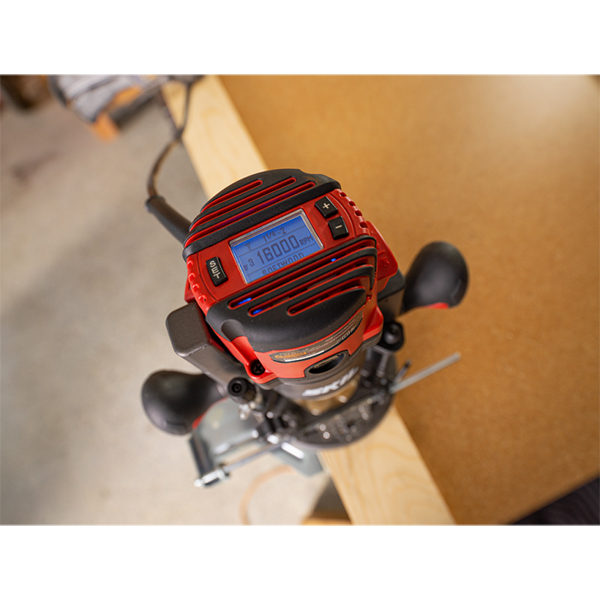
The weight of the tool is what you’d expect for a router of this size—no surprise there, and its handling in both bases is pleasant. The handles really are comfortable, and all adjustments operate smoothly and as anyone familiar with routers would expect. The 1322 bases include a click/detent coarse adjustment that sets the tool into one of three positions in the base, and a fine adjustment screw (that works with a customary depth-stop turret on the plunge base). All in all, this router is fully-featured, sports traditional controls, and performs reliably. It delivers solid general-purpose performance at a very reasonable price (it’s currently going for $140 on Amazon).
Fixed and Plunge Bases
You want to have both a fixed base and a plunge base for your router. True, different pros will tell you that they mostly use one or the other, but each base can do things that the other can’t do—or at least can do them much more easily. The SKIL 1322 comes with both as part of its package.
The fixed base has the usual router (motor) clamp. Coarse depth adjustments, and threaded fine adjustment capability. It incorporates edge guide mounting slots with friction hold levers. Also integral is a vacuum port and chip shield. The non-marring sub-base is a nice feature, and it is easily removed in order to attach the router table mounting plate (see below).
The plunge base is also traditionally set up with depth rod for setting the plunge depth, a fine adjustment dial integral to it, a depth-stop turret for incrementally increasing the plunge depth, a chip shield, and a non-marring sub-base. Nothing unusual in either of these bases and all the features you’d expect in a professional router are there.
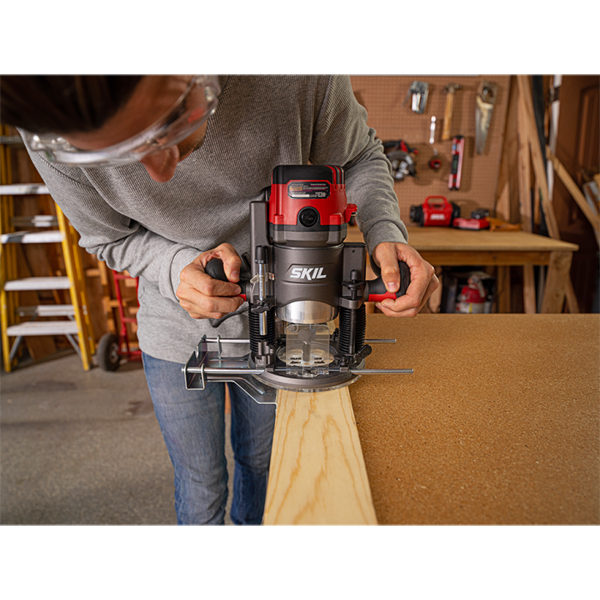
Intuitive Use
I tested this router on a bunch of scrap pieces, and so long as I stuck to good professional practice (for example, restricting the depth of cut to one-half the bit’s spindle diameter) the router just chugged along. Of course, like any cutting tool, performance is as much — if not more — a function of the blade than the tool itself, but both are certainly important. For my tests, I used the starter bit set sold by SKIL (see below). My main test mediums were hard dried oak and weathered pressure-treated stock. Round over, straight, ogee, and dovetail bits all cut through each wood type as fast as I could move and control the router. I wasn’t doing any framing at the time, but I screwed some 3/8-inch OSB to a few 2x6s and tried out a ½-inch Diablo pilot panel bit with the plunge base; so long as I drove the tool correctly I could punch out sections of sheathing lickety-split.
Later I used the round over bits to dress up some PT garden posts (another router used in rough carpentry), and used other bits to practice more with pine, maple, and MDF in anticipation of a couple of projects later this summer. (Practice is essential to learning to use a router; much of your technique will come from experience.) I found the 1322 to be intuitive and easy to use, and it never bogged down. The edge guide also worked just as expected. You can’t easily access the power switch from the operating hand position, but you don’t really want to be starting a router up with the bit in contact with wood anyway (I’m sure there are exceptions, but…).
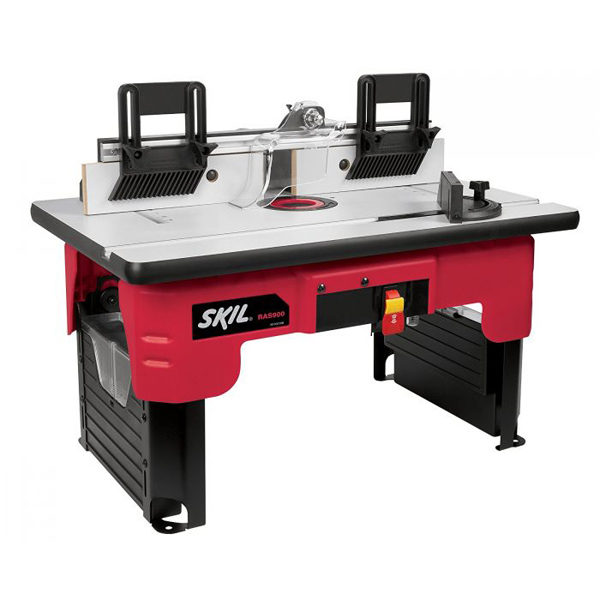
SKIL Router Table
A hand-held router, in which the tool is run over the workpiece, represents only half of a router’s capability. With the router affixed upside-down to a table, and the workpiece run over the spinning bit, many other jobs can be performed. It’s a rare carpenter that has a router and not a router table so as to have both capabilities.
Rob has jokingly described a router table a really nothing more than a slab of wood with a hole in it. I suppose that would suffice if you found yourself on a desert island with a router (happens all the time, right?). But describing a router table like that is sorta like saying a gun is nothing more than a pipe with a nail attached to a rubber band.
A proper router table — one that supports the workpiece, has a fence that guides it, accepts different size bits, includes scales, and so on — is pretty much necessary to do efficient work. And if it’s not necessary on any particular job site, it’s crucial in a shop. There’s a reason that woodworkers go to great lengths and expense to build the “perfect” router table for their shops.
Someone doing general carpentry both on job sites and in a shop is well served by a full-featured, portable router table that can be quickly set up. And certainly for the beginner, going this route is the best way. SKIL makes a very nice router table (model RAS900) that has most of the features you’d ever want in a router table. It folds down into a compact package for transport or storage, and the mounting plate accepts not only SKIL routers but many other popular ones.
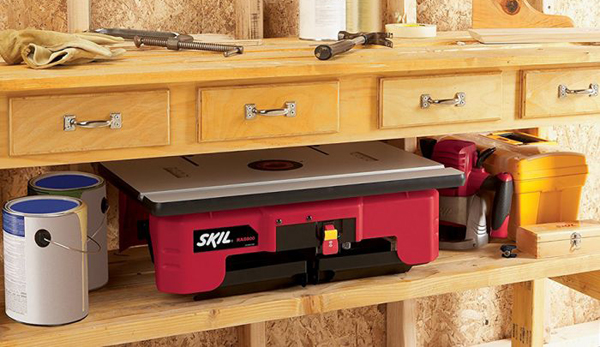
SKIL Router Table Features:
- Pre-assembled
- Laminated MDF table
- Accessory storage containers protect and store accessories
- Two featherboards
- Bit height gauge
- Starter pin and guard
- Easy quick-release router mounting
- Miter gauge
- Three bit-clearance inserts
- Split fence to accommodate different bit widths
- Shims for jointing
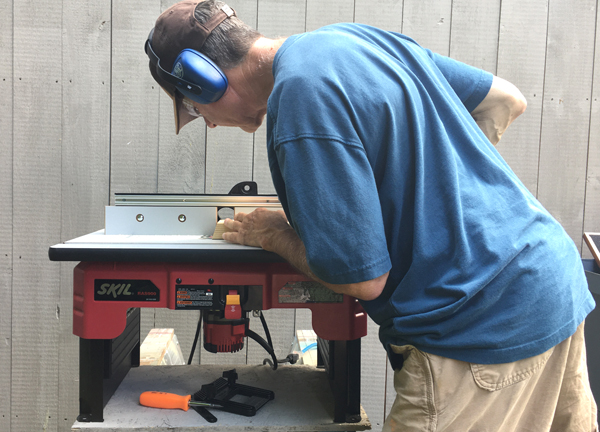
This is a great table to take to the job-site, given its features and fold-down capability. As a complete turnkey solution, it’s also a great table for the newbie. It is surprisingly stable, and the table height is 14 inches. Did you know that there’s a “correct” — that is, most ergonomic—height for a router table? To achieve it, I cut down a set of sawhorses to set the RAS900 on. As a bonus, I now have a shorter set of horses that come in handy in quite a few other circumstances. Win-win. The SKIL RAS900 goes for $170ish on Amazon.
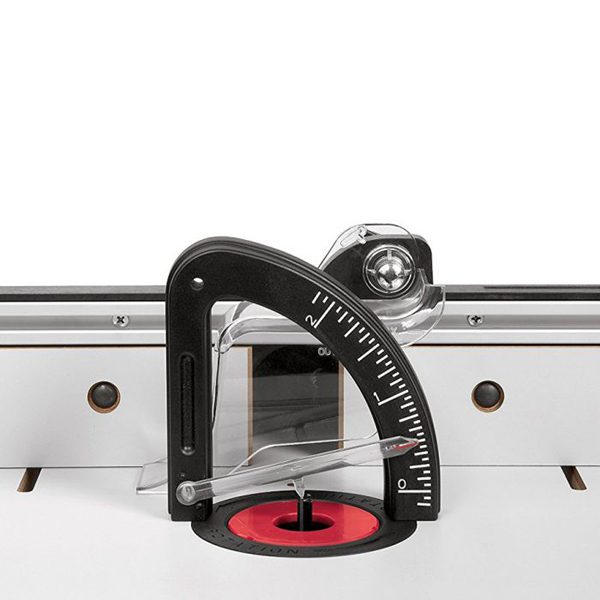
SKIL 15-Piece Router Bit Set
Of course, you need bits to go with the router. Like any edged tool—saw blades, chisels, planes, etc. — router bits range from inexpensive and basic to prized tools that you’d have to take a mortgage on. If you’re a pro you know what bits you use and what quality level you demand. If you’re new to the router, SKIL sells a nice 15 piece bit set that includes most of the basic shapes: straight, ogee, round over, dovetail, and so on. I used the RTB7500 bit set during this entire evaluation and found that these bits in this router gave me no complaints; every bit cut every path fast and smoothly. I can’t tell you how long they’d last in a production environment, but I certainly expect to be using them for a long time. Right now they’re $59 on Amazon.
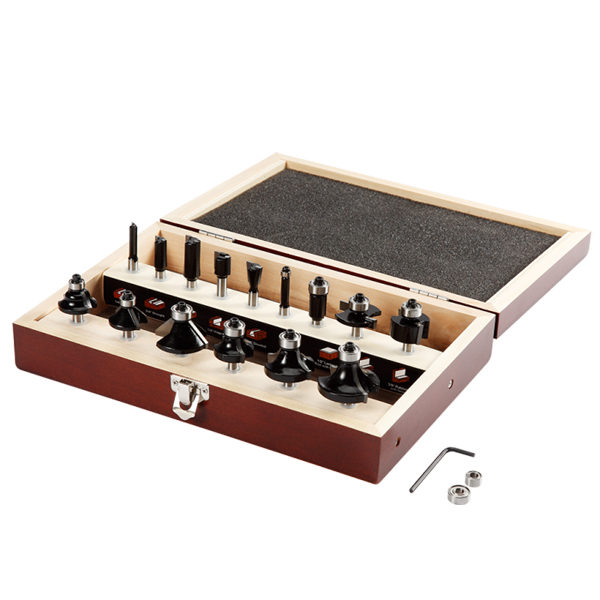
Bottom Line
All in all, I’d describe the SKIL 1322 as a full-featured, mid-power, a highly versatile router that can do the myriad of router jobs: edge profiling, carving, boring, joinery, template routing, surfacing, cutting, and…well, the list goes on and on. And all of this at a very attractive price point! This router would be ideal for a beginner, and it’s just a suitable as a “go-to” router for a remodeling or general contractor pro. Just don’t forget to maintain it occasionally.
A note for beginners: there are probably a hundred good YouTube videos and Web articles on how to use a router. There’s a lot to learn, and the number of different bits and what you can do with them is mind-boggling (although most people wind up using only a few on a regular basis). If you have the basics of carpentry down, adding router capability to your skillset will dramatically increase the number and kinds of jobs you can tackle.



